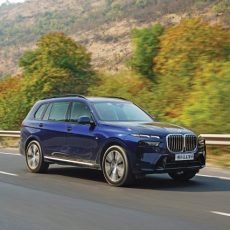
In the interior department, the new Magnite tries to provide a good equipment level while also providing commendable space. The interior features some elements from the Renault Triber parts bin — including some buttons and controls on the centre console. And that’s not a bad thing at all. Like the Triber, it feels thoughtfully laid-out and comfortable to be in. The hexagonal air-vents and simple trim accents in matte-aluminium finish are nice touches. The tacky driver info-console makes up by being rather informative. The centre touchscreen, however, feels nice and also has the feed from the 360° camera. The seats are in a simple fabric and are well-supportive and the ergonomics make for comfortable long journeys.
The Urban Cruiser shares its layout with the Brezza and that means a spacious, decently appointed cabin with a centre touchscreen — the rage these days — and a set of easy-to-use and easy-to-reach controls. As with a Toyota — and Maruti Suzuki — everything just… works. It’s enough and there’s enough room for occupants and luggage thanks to the clever use of space.
The Venue and Sonet have, by far, the best interior in terms of material, quality of finish, and equipment, which is only expected considering the 15-30 per cent premium they demand. The South Koreans and their learning curve have been spoken about often and for good reason. It’s a clear and consistent evolution.
In terms of powertrain, the Magnite is the only petrol with a continuously variable transmission (CVT) among the lot on sale — amidst torque converters, automated manuals, and dual-clutch autos. And, being Nissan’s trademark Xtronic CVT, adds a bit of heritage and assurance value and a choice of an “L” lever position too.
A lot of the cars are available with 1.0-litre, three-cylinder, turbo-petrol engines, with port or direct injection. The Magnite uses the new “HRA0” 999-cc port-injected motor with a hefty 100 hp and 152 Nm of torque peaking from 2,200 rpm (160 Nm for the manuals). This powertrain pairing is rather potent as the turbo-petrol engine has a hefty bottom end and that fills up the taking-off-from-standstill and low-speed acceleration areas well. The front-wheel-drive layout is the standard format for all sub-compact crossovers on sale today, barring a few more premium ones. The ride is soft and pliant, but it can get a little bouncy when tackling undulations and potholes. The dampers need to do a better job. It’s not unsettling, though, but it invoked a more careful approach from me the next time I saw potential trouble. The heavy steering is power-assisted and feels nice on the move. The added effort at crawl speeds, for instance, or when parking is a negligible compromise for what it offers at speed.

The Urban Cruiser and the Vitara Brezza use the “K15” four-cylinder naturally aspirated petrol motor with the automatic version getting a mild-hybrid system that makes for energy recuperation and torque assist. It’s easy to drive but the shifts aren’t the most urgent, with the three later ratios spacing themselves out quite thin at times. The motor feels reasonably potent for everyday use but it’s the torque assist, especially after it builds up energy reserve, that provides a quick kick to the acceleration; something I found often in stop-go traffic which, let’s be honest, isn’t the best time for any sort of kick. That said, the ride is nice and they both soak up the bumps well. However, driver engagement isn’t their USP.
The Hyundai Venue and the Kia Sonet are next with their 998-cc in-line triple with turbocharging and petrol direct-injection — hence the “T-GDI” nomenclature. The global motor makes a heady 120 hp and 172 Nm which, in turn, make for quick acceleration and a full torque band pretty much across the rev-range, starting from just 1,500 rpm.
The seven-speed, dual-clutch automatic in the Sonet is a thing of beauty and makes for precise shift-points and seamless, linear acceleration through the gears. The ride quality, too, is sublime and that means a comfortable long-distance stint with no bother. The sound insulation, ergonomics, and the equipment and connectivity on offer are impeccable. That, of course, comes at a price.
The Venue, on the other hand, had the intelligent manual transmission with the six-speed, double-H-gate shifter accompanied by just two pedals; leading to quite a bewildered look on the face of those seeing it for the first time. Even so, the automated clutch action is welcome considering the present state of traffic. The system works well. The disengaging and re-engaging of the clutch plate is well taken care of, the only chink being a quick-shift at high revs throwing up some confusion. It resisted but eventually acknowledged the need to hug the next cog. It isn’t meant to take part in a rally, of course. It’s made to bring the engagement of a manual with the convenience of an automatic. And it works.




